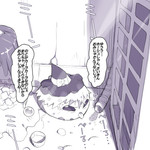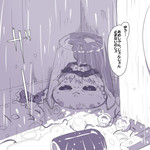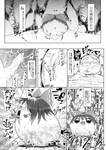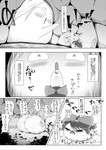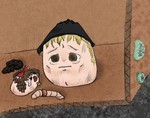
mold
Introduction
A mold or mould is a fungus that grows in the form of multicellular filaments called hyphae. It usually appears as a flat layer of green or black patches. Since Yukkuri are essentually bean paste buns, there's a chance for them to grow mold.
Epidemiology
Mold is the most common disease to afflict a yukkuri. Mold generally infects dirty yukkuris and as such generally infects their feet or bottom which are generally the dirtiest parts. Being damp is also a risk factor especially if one is covered with urine. Malnutrition seems to be also a risk factor in mold infections though it is unclear how much malnutrition affects mold risk as malnutritioned yukkuris tend to also be dirty.
Koyukkuris are particularly vulnerable to mold attacks as they usually can't shit or pee without dirtying themselves and are unable to clean themselves.
Mold can transmit via contact from yukkuri to yukkuri. A koyukkuri suffering from mold is particularly at risk of infecting other yukkuris as they will often attempt to comfort themselves by rubbing with other yukkuri.
As mold is usually caused by dirty feet or anyaru, flying species such as Remilias and Flandres and aquatic species such as Nitoris are rarely affected by mold. Those aforementioned species' are also predator yukkuri which are generally smarter than normal yukkuris and will avoid eating moldy preys.
Signs and Symptoms
Most molds is easily distinguished by a dark greenish growth on a yukkuri, almost always at their bottom parts. Some molds have unique adaptations that can make them harder to distinguish such as a mold that mimics the appearance of a pet clothing, but these are rare.
Yukkuris suffering from mold will feel weak and lethargic. Itching on the affected areas is a common symptom though it doesn't always happen. It is sometimes accompanied with diarrhea if the mold spreads into their anyaru. Vomiting can also occur but these are rare as molds tend to attack the lower parts of a yukkuri.
Evaluation
Molds can be diagnosed by sight and no special testing is required
Treatment
Molds can be cured simply by applying orange juice to the affected area. The affected yukkuri should also get plenty of rest and sufficient food. Increased drinking water may be needed if they suffer from diarrhea.
If orange juices aren't avalaible, the second line treatment is to surgically remove the affected area. This is risky and can result in death if the surgeon is not careful with the removal, especially if it affects a koyukkuri as their bodies are small. Anesthesia should be used if avalaible as the yukkuri wriggling their bodies from the pain of surgery can increase the risk of death. If possible, restore the removed areas with flour dough which will greatly increase their survival chance. This option doesn't guarantee a remission as severely infected yukkuris might have mold inside their paste fillings too.
Prevention
As said, mold is generally caused by bad hygiene. As such the easiest way to prevent mold is maintaining a good hygiene. A koyukkuri should regularly be cleaned off it's excrement. If diapers are used remember to replace them every now and then.
It's important to remember that mold transmits via contact and as such the moldy yukkuri should be quarantined from other yukkuri. Other yukkuri should be educated to avoid rubbing with the infected yukkuri. On a koyukkuri such treatment might cause stress and as such they should be provided toys to distract them from the loneliness.
Prognosis
Domesticated yukkuris generally have a good prognosis as their owner can easily cure them.
Gutter trashes will often need to resort to either seeking out a thrown away bottles/cans of orange juice and hoping for leftovers or begging for a human to give them orange juice, neither of which are reliable.
On wild yukkuris that live in clans with a wise patchouli leader, some patchys are smart enough to know that you can produce orange juice from mikans (oranges) and those clans will usually stockpile mikans as medicine. Those clans also generally have proper quarantine etiquette and facilities can can prevent a spread of infection.
However with all that said, orange juice are geneally not readily avalaible for non-domesticated yukkuris. As such most wild yukkuris rely on surgically removing the mold with sticks hope that the yukkuri survived the surgery. Lack of proper quarantine facilities also often lead to an infected ko disobeying their parent's no-rub instruction and spread the infection to the rest of the family.
Some families and clans even ended up deeming that a mold is a death sentence and any yukkuri infected with a mold is either banished or killed in order to prevent the infection from spreading.
Koyukkuris being smaller and more vulnerable tend to die from molds quicker. Adult yukkuris are often seen surviving mold for longer periods of time. Some particularly durable adults might even be able to live with moldy feet, deeming the mold as nothing but a hindrance. Still, even if one survives mold, the decreased mobility and survivability tend to eventually cause the yukkuri to die by other means instead.
